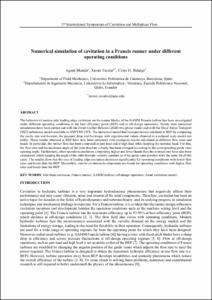Mostra el registre d'ítem simple
Numerical simulation of cavitation in a Francis runner under different operating conditions
| dc.contributor.author | Mundet, Agustí |
| dc.contributor.author | Escaler Puigoriol, Francesc Xavier |
| dc.contributor.author | Hidalgo, Víctor Hugo |
| dc.contributor.other | Universitat Politècnica de Catalunya. Departament de Mecànica de Fluids |
| dc.date.accessioned | 2019-05-28T14:35:20Z |
| dc.date.available | 2019-05-28T14:35:20Z |
| dc.date.issued | 2019 |
| dc.identifier.citation | Mundet, A.; Escaler, X.; Hidalgo, V. Numerical simulation of cavitation in a Francis runner under different operating conditions. A: International Symposium of Cavitation and Multiphase Flow. "The 3rd International Symposium of Cavitation and Multiphase FlowShanghai, China, April 19th-22nd, 2019 ISCM2019: accepted abstracts, full papers". Shanghai University Press, 2019, p. 1-8. |
| dc.identifier.uri | http://hdl.handle.net/2117/133596 |
| dc.description.abstract | The behavior of suction side leading edge cavitation on the runner blades of the GAMM Francis turbine has been investigated under different operating conditions at the best efficiency point (BEP) and at off-design operations. Steady state numerical simulations have been carried out with the Zwart-Gerber-Belamri (ZGB) two-phase model and with the Shear Stress Transport (SST) turbulence model available in ANSYS¿ CFX. The numerical model had been previously validated at BEP by comparing the cavity size and location, the pressure drop and the torque with experimental values obtained in a reduced scale model testutility. These results obtained at BEP have now been compared with analogous results calculated at different flow rates and heads. In particular, the runner flow has been computed at part load and at high load while keeping the nominal head. For that, the flow rate and the incidence angle of the inlet absolute velocity has been changed according to the corresponding guide vane opening angle. Furthermore, other operation conditions comprising higher and lower heads than the nominal one have also been considered, while keeping the angle of the inlet absolute velocity constant as if the guide vane position were the same for all the cases. The results show that the size of leading edge cavitation decreases significantly for operating conditions with lower flow rates and heads than the BEP. Meanwhile, similar cavitation developments are found for operating conditions with higher flow rates and heads than the BEP. |
| dc.format.extent | 8 p. |
| dc.language.iso | eng |
| dc.publisher | Shanghai University Press |
| dc.rights | Attribution-NonCommercial-NoDerivs 3.0 Spain |
| dc.rights.uri | http://creativecommons.org/licenses/by-nc-nd/3.0/es/ |
| dc.subject | Àrees temàtiques de la UPC::Enginyeria mecànica::Mecànica de fluids::Màquines hidràuliques i de fluids |
| dc.subject.lcsh | Cavitation |
| dc.subject.lcsh | Turbines--Blades |
| dc.subject.other | Inlet blade cavitation |
| dc.subject.other | Francis runner |
| dc.subject.other | GAMM turbine |
| dc.subject.other | Off-design operation |
| dc.subject.other | Zwart cavitation model |
| dc.title | Numerical simulation of cavitation in a Francis runner under different operating conditions |
| dc.type | Conference report |
| dc.subject.lemac | Turbines hidràuliques |
| dc.contributor.group | Universitat Politècnica de Catalunya. CDIF - Centre de Diagnòstic Industrial i Fluidodinàmica |
| dc.description.peerreviewed | Peer Reviewed |
| dc.relation.publisherversion | http://www.iscm2019.org/index.asp |
| dc.rights.access | Open Access |
| local.identifier.drac | 24252178 |
| dc.description.version | Postprint (published version) |
| local.citation.author | Mundet, A.; Escaler, X.; Hidalgo, V. |
| local.citation.contributor | International Symposium of Cavitation and Multiphase Flow |
| local.citation.publicationName | The 3rd International Symposium of Cavitation and Multiphase FlowShanghai, China, April 19th-22nd, 2019 ISCM2019: accepted abstracts, full papers |
| local.citation.startingPage | 1 |
| local.citation.endingPage | 8 |


